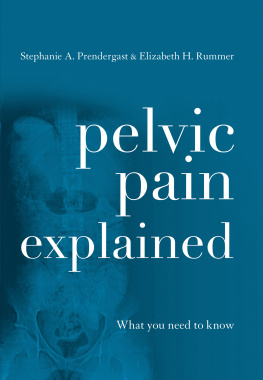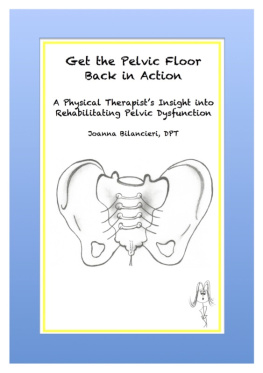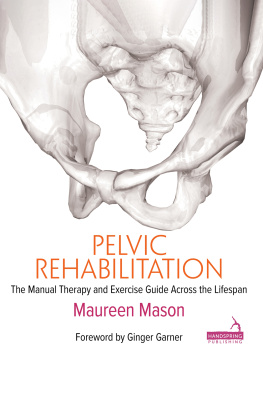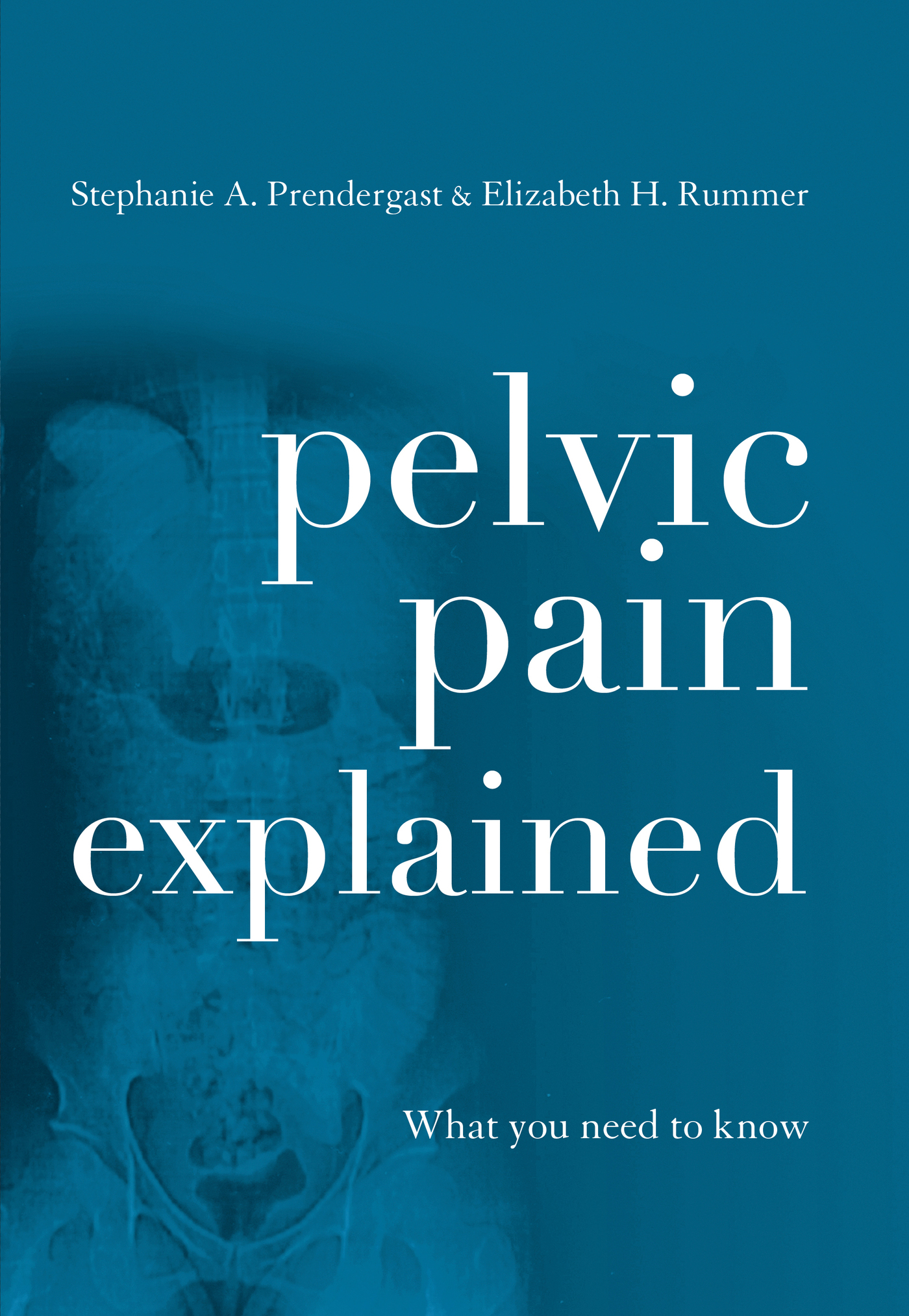Pelvic Pain Explained
Pelvic Pain Explained
What You Need to Know
Stephanie A. Prendergast and
Elizabeth H. Rummer
ROWMAN & LITTLEFIELD
Lanham Boulder New York London
Published by Rowman & Littlefield
A wholly owned subsidiary of The Rowman & Littlefield Publishing Group, Inc.
4501 Forbes Boulevard, Suite 200, Lanham, Maryland 20706
www.rowman.com
Unit A, Whitacre Mews, 26-34 Stannary Street, London SE11 4AB
Copyright 2016 by Rowman & Littlefield
All rights reserved. No part of this book may be reproduced in any form or by any electronic or mechanical means, including information storage and retrieval systems, without written permission from the publisher, except by a reviewer who may quote passages in a review.
British Library Cataloguing in Publication Information Available
Library of Congress Cataloging-in-Publication Data
Prendergast, Stephanie A., 1976
Pelvic pain explained : what you need to know / Stephanie A. Prendergast and Elizabeth H. Rummer.
pages cm
Includes bibliographical references and index.
ISBN 978-1-4422-4831-1 (cloth : alk. paper) ISBN 978-1-4422-4832-8 (electronic)
1. Pelvic floorDiseases. 2. Pelvic floorDiseasesTreatment. I. Rummer, Elizabeth H., 1976 II. Title.
RG482.P74 2016
617.5'5dc23
2015024826
 TM The paper used in this publication meets the minimum requirements of American National Standard for Information Sciences Permanence of Paper for Printed Library Materials, ANSI/NISO Z39.48-1992.
TM The paper used in this publication meets the minimum requirements of American National Standard for Information Sciences Permanence of Paper for Printed Library Materials, ANSI/NISO Z39.48-1992.
Printed in the United States of America
Foreword
If you suffer with pelvic pain, you need to read this book. Maybe several times. If you have a loved one with pelvic pain, both of you need to read this book. If you are a clinician who cares for patients with pelvic pain, you need to read this book. It is a down-to-earth, clearly written book that will educate and guide you in managing and relieving persistent pelvic pain.
As you will learn when you read Pelvic Pain Explained, persistent pelvic pain is a common condition that affects people of every race, gender, socioeconomic group, and professionit is a ubiquitous condition of all humans. It is as common as asthma, migraine, and low back pain. As is the case for all persistent pain conditions, it affects all aspects of the sufferers life, but because of the location in the pelvis, it usually affects sexuality and intimacy far more than is the case with other pain conditions. For that reason, Liz and Stephanie devote a whole chapter to sex and pelvic pain.
Some may be concerned that the authors of this book are physical therapists, not physicians. You should not be. I am a physician who spent most of my clinical and academic career dedicated to caring for patients with persistent pelvic pain, doing research on pelvic pain, and teaching others about pelvic pain. I was one of the three founders of the International Pelvic Pain Society. This society has grown to be a premier organization dedicated to teaching about and care of patients with pelvic pain. It has more members who are physical therapists than physicians. When you read this book, you will have a clear understanding of why that is the case. I learned very early in my career that persistent pelvic pain, for all intents and purposes, always involves the musculoskeletal system, either as a primary or a secondary generator of pain. Physical therapists are ideal clinicians to deal with the musculoskeletal sources of pelvic pain, even when other bodily systems are also involved. They should always be part of the treatment team. So it is very appropriate that two physical therapists wrote Pelvic Pain Explained.
Stephanie and Liz are ideal physical therapists to be authors of this book. As they explain in their introduction, they have 30 years of combined experience both treating patients and educating providers. They have worked hard in their careers not only educating others, but also educating themselves. They have treated thousands of patients, male and female, and have a deep understanding of the approach to treatment that is needed if it is to be successful. This includes the strong involvement of the patient. Thus, they devote the whole third segment of their book to what the patient must do to stop being a patient, and return to being a person. One of the most consistent frustrations during my 30 years treating women with persistent pelvic pain was the realization that if I was working harder than my patient to try to make her better, then we were both doomed to failure. Liz and Stephanie tell you in Pelvic Pain Explained what you need to do so that will not happen to you and your health care team. Additionally, they will help you navigate the complexities of our health care systems so you can find a team of clinicians that can educate, treat, and guide you to relieving your pain. Persistent pelvic pain is a complicated malady, and you will find that no one single provider will be able to help with you all the aspects of education and treatment that you will need.
So read this book if you are a patient, have a loved one, or are a clinician dealing with pelvic pain. Let it help you on your path to being well and pain-free, or having your loved one or your patient be pain-free.
Fred M. Howard, M.S., M.D.
Chairman of the Board
International Pelvic Pain Society
Professor Emeritus of Obstetrics and Gynecology
University of Rochester School of Medicine and Dentistry
St. John
United States Virgin Islands
Note
There is some debate regarding the use of the terminology persistent pelvic pain or chronic pelvic pain. Currently, the thinking is that pelvic pain is not always chronic, that in many cases it can be cured or at least very well controlled. Thus, chronic is thought by many experts to be an inappropriate name and persistent more appropriate to the condition.
Acknowledgments
Thank you to Bonnie Bauman whom without her initiation, contributions, and support this book would not have been written. Thank you to Maria Lluberes for her wonderful illustrations.
We would like to thank the thousands of patients that trusted us with their health, providing us with the knowledge, experience, and passion to write this book. We would like to give a special thank you to Rhonda Kotarinos who paved the way for us as well as other physical therapists in this field. As the field grew, the International Pelvic Pain Society (IPPS) helped us further our education but also provided us with our first platform for teaching. We know this book would not have happened without each other and our extremely committed PHRC team. And, finally, we thank our supportive friends and family who are always there through our joys and successes.
Introduction
Anyone with persistent pelvic pain knows that getting on the right treatment path is often half the battle. The main reason for this is that persistent pain in general is a poorly understood medical condition compared to other diagnoses. So at the end of the day, many people with pelvic painwhile in the throes of dealing with symptoms that wreak havoc on their daily livesare struggling to find answers. Theyre not alone in their frustration. Medical providers are often equally at a loss as they find themselves up against a lack of available research and education. The good news is that in recent years, a growing group of physicians, pelvic floor physical therapists, and psychologists are becoming actively involved in the research and management of pelvic pain syndromes. But while the landscape for treatment
Next page







 TM The paper used in this publication meets the minimum requirements of American National Standard for Information Sciences Permanence of Paper for Printed Library Materials, ANSI/NISO Z39.48-1992.
TM The paper used in this publication meets the minimum requirements of American National Standard for Information Sciences Permanence of Paper for Printed Library Materials, ANSI/NISO Z39.48-1992.